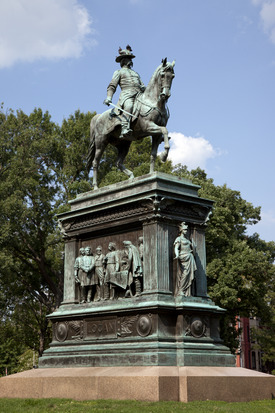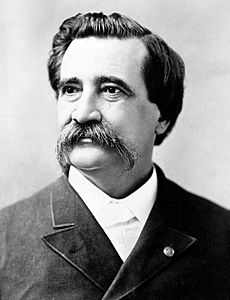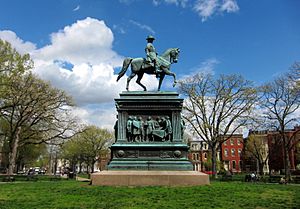Equestrian statue of John A. Logan facts for kids
 |
|
| Coordinates | 38°54′35″N 77°01′47″W / 38.909644°N 77.029647°W |
|---|---|
|
Equestrian statue of John A. Logan
|
|
|
U.S. Historic district
Contributing property |
|
| Part of | Civil War Monuments in Washington, D.C. |
| NRHP reference No. | 78000257 |
| Added to NRHP | September 20, 1978 |
| Location | Logan Circle, Washington, D.C., United States |
| Designer | Franklin Simmons (sculptor) Richard Morris Hunt (architect) Fonderia Nelli (founder) Cranford Paving Company (contractor) |
| Material | bronze (sculpture) bronze and granite (base) |
| Length | 10 feet (3.0 m) |
| Width | 4.05 feet (1.23 m) |
| Height | 12 feet (3.7 m) |
| Opening date | April 9, 1901 |
| Dedicated to | John A. Logan |
The Major General John A. Logan monument is a special statue in Washington, D.C.. It's also called the General John A. Logan Monument or Logan Circle Monument. This equestrian statue (a statue of a person on a horse) honors John A. Logan. He was an important politician and a general during the American Civil War.
You can find the monument in the middle of Logan Circle. This area is a public park and a traffic circle in the Logan Circle neighborhood. The statue was created by artist Franklin Simmons. He also made the Peace Monument and other statues in the National Statuary Hall Collection. The base of the statue was designed by Richard Morris Hunt. He was a famous architect who designed buildings like the Metropolitan Museum of Art in New York City. The monument was officially opened in 1901. Important people like President William McKinley were there.
This statue is one of eighteen Civil War monuments in Washington, D.C. All these monuments were added to the National Register of Historic Places in 1978. The statue is made of bronze and sits on a base of bronze and granite. The National Park Service takes care of the monument and the park around it.
Contents
History of the Logan Monument
Who Was John A. Logan?
John A. Logan (1826–1886) was born in Illinois. He fought in the Mexican–American War as a second lieutenant. After the war, he studied law at the University of Louisville. Logan started his political career as a member of the Democratic Party. He was elected as a state senator and then to the U.S. House of Representatives.
When the American Civil War began, Logan first spoke out against extreme views on both sides. But he soon joined the Union Army. He fought in the First Battle of Bull Run. He then left Congress and became a colonel. He helped create the 31st Illinois Volunteer Infantry Regiment. Logan was wounded twice during the war. He was known as an excellent leader on the battlefield. He became a brigadier general after the victory at Fort Donelson. Logan also played a big part in the Union's success at Vicksburg. He even served as the military governor of that area.
After the war, Logan continued his political career. He was elected to the U.S. House of Representatives as a Republican. Later, he became a U.S. Senator. In 1884, he ran for Vice President but lost the election. Logan was a strong supporter of military veterans. He helped start two veteran groups: the Grand Army of the Republic (GAR) and the Society of the Army of the Tennessee (SAT). He also helped make Memorial Day an official holiday. It was first celebrated in 1868.
Building the Monument
After Logan passed away in 1886, the Society of the Army of the Tennessee (SAT) wanted to build a monument for him. They worked with the Grand Army of the Republic (GAR) and Logan's wife, Mary. Together, they raised money and asked Congress for approval. Congress approved the monument on March 2, 1889.
A special group was formed to choose the sculptor and the location. They asked famous sculptor Augustus Saint-Gaudens for advice. He suggested Franklin Simmons, an American artist living in Rome. Simmons had already created several Civil War monuments, including the Peace Monument in Washington, D.C.
The group looked at models from several sculptors. In December 1892, they chose Simmons's design. Mary Logan especially liked his model. She liked how the statue looked and Simmons's idea to have a bronze base. Most other monuments had granite bases. Mary also wanted to help decide what scenes would be shown on the statue's base. Simmons was paid $65,000 for his work.
Creating the statue was harder than Simmons expected. It was his first and only statue of a person on a horse. He had to ask for more time to finish it. The bronze base was designed by architect Richard Morris Hunt. The Fonderia Nelli company cast the bronze parts. They finished the base in just three and a half months. The Cranford Paving Company prepared the site and laid the granite foundation. The base was installed on April 18, 1898.
Simmons finished the sculpture in 1900, and it was cast in Rome. A special ceremony was held there, and Simmons was even honored with knighthood. The sculpture then traveled to the United States. It arrived in Washington, D.C., on January 16, 1901. One week later, it was placed on top of its base.
The monument was placed in the center of Iowa Circle. This park was in a nice neighborhood. The park was redesigned in 1891 to make space for the statue.
Dedication Ceremony
The monument was officially dedicated on April 9, 1901. Temporary platforms were built for important guests. These guests included President William McKinley, members of his team, Senators Chauncey Depew and Shelby Moore Cullom, General Grenville M. Dodge, and Mary Logan with her family. Representatives from the GAR and SAT were also there, along with sculptor Franklin Simmons.
Before the ceremony, a large military parade took place. It included soldiers, marines, sailors, and veterans. General Dodge, who was president of the SAT, led the ceremonies. Logan's grandson, George Tucker, pulled a cord to reveal the statue. The crowd cheered and applauded. The Fourth Artillery fired a national salute.
President McKinley gave a speech. He said that honoring patriots inspires great deeds. He called Logan "the ideal volunteer soldier of two wars." Senator Depew also spoke, praising Logan as a hero. Senator Cullom read a letter from the governor of Illinois, honoring Logan. The ceremony ended with a prayer.
Later Years
In 1930, Congress renamed Iowa Circle to Logan Circle. This was to honor John A. Logan, who had lived nearby in 1885. The Logan monument is one of eighteen Civil War monuments in Washington, D.C. It was added to the National Register of Historic Places (NRHP) in 1978. It is also part of the Logan Circle Historic District. The National Park Service owns and takes care of the monument and the park.
Design and Location
The monument stands in the middle of Logan Circle. This is a 1.8-acre public park and traffic circle. It's where 13th Street, P Street, Rhode Island Avenue, and Vermont Avenue NW meet. Sidewalks lead from the edge of the circle to the monument. About twenty oak trees are planted around the circle. A small iron fence surrounds the statue's base.
The bronze statue of Logan on his horse is 12 ft (3.7 m) tall. It is 10 ft (3.0 m) long and 4.05 ft (1.23 m) wide. It weighs about 11,000 lb (5,000 kg). Logan is shown with his Civil War military uniform. He is holding the horse's reins with his left hand. His right hand holds his sword pointing down. The horse is walking forward with its right front foot raised. You can see "FOND. NELLI ROMA 1897" and "FRANKLIN SIMMONS" written on the statue.
The statue sits on a rectangular bronze base. This base is on top of a low granite base. The bronze base is 30 ft (9.1 m) high, 22 ft (6.7 m) long, and 3 ft (0.91 m) wide. It weighs about 35,000 lb (16,000 kg). A bald eagle is on each corner of the bronze base. These eagles represent Patriotism. Around the name "LOGAN" are palm leaves, which stand for Victory.
The west side of the base has a relief (a carved picture). It shows Logan with other officers discussing the Civil War. Some officers are looking at a map spread on a table. The east side of the base has another relief. It shows Logan being sworn in as a senator by Vice President Arthur. Other senators are also shown in this carving.
On the north and south sides of the base are female figures. The figure on the north side represents Peace or Victory. She holds a laurel wreath and a fasces. The figure on the south side represents War. She holds a shield and a sword.
Images for kids
-
Row houses on the northwest corner of Logan Circle
See also
 In Spanish: Estatua ecuestre de John A. Logan para niños
In Spanish: Estatua ecuestre de John A. Logan para niños




